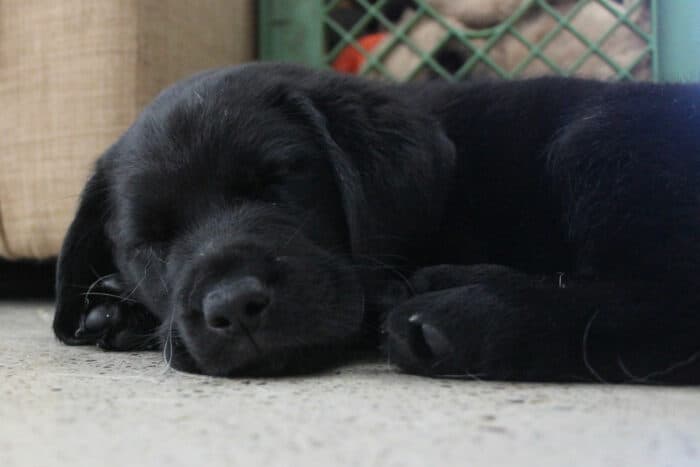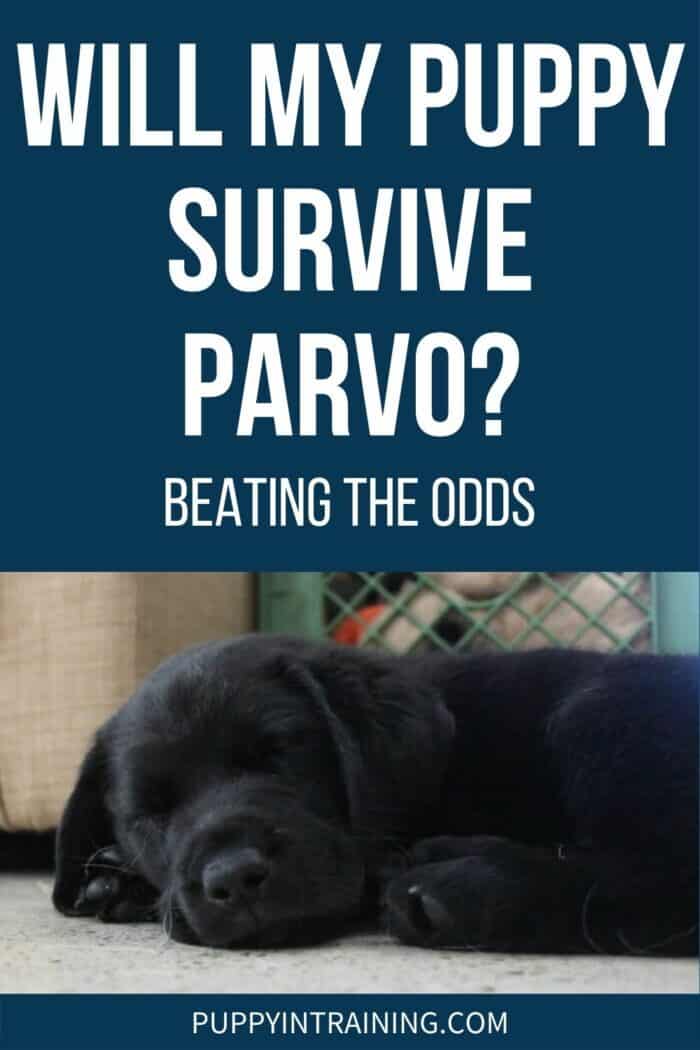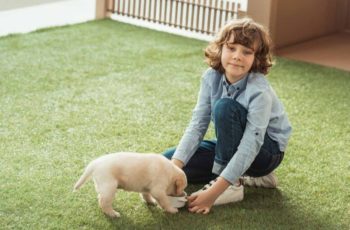This post may contain affiliate links. We may earn money or products from the companies mentioned in this post.
Canine Parvovirus: It’s the virus that wreaks havoc on a puppy’s gastrointestinal system and a diagnosis every dog owner fears hearing!
What are the chances that a dog with parvo will survive?
Learning that your pup has canine parvovirus is beyond scary—it’s terrifying! When faced with this diagnosis the first question you’d want to ask is, “How do I know if my puppy will survive parvo?”

Disclaimer: We are not veterinarians. If you think your puppy is sick you should consult your veterinarian immediately.
Unfortunately, canine parvovirus in puppies is very common and often fatal. When not diagnosed or treated in time, parvo’s mortality rate is as high as 91%!
Immediate diagnosis and treatment are paramount and will significantly increase your puppy’s chance of surviving parvo.
With aggressive treatment and proper care, your puppy has a good chance of making a full recovery and reaching a ripe old age.
In this article, I will tell you everything you need to know about canine parvovirus. Keep on reading to learn if a puppy can survive parvo, signs that your pup is recovering, and much more.
What Is Parvovirus?
While most dog owners have heard of parvo, only those who’ve cared for an infected puppy truly understand how devastating this virus is.
Parvo has a high mortality rate and is one of the most infectious viruses that affect dogs.
The scary thing is, parvo can survive in the soil for years, and you can pick it up outside and transfer it to your puppy without knowing it!
Your puppy can also contract parvo through direct contact with an infected dog, so be extra vigilant if you are raising sibling puppies.
Another possible scenario of catching parvo is by indirect contact with a contaminated object.
So, every time your puppy goes outside and sniffs or licks doggy poop, there is a chance of exposure if the poop is contaminated.
Furthermore, your puppy can get parvo if they play with an infected dog or puppy, or touch a food bowl, leash, collar, or harness used by an infected dog.
Canine parvovirus is classified as a gastrointestinal disease since it causes the most damage to the stomach and small intestines. This virus destroys cells in the small intestines, which diminishes nutrient absorption.
The most common symptoms of parvovirus are:
- Loss of appetite
- Fever
- Vomiting
- Bloody diarrhea
- Abdominal pain
- Lethargy
If your puppy is experiencing any of these symptoms, don’t waste a second—take them to the veterinarian straight away!
How Do I Know If My Puppy Will Survive Parvo
Most puppies die from parvo within 48 to 72 hours following the onset of the first symptoms. Immediate reaction and treatment are crucial and will significantly improve your puppy’s chance of surviving parvo.
Our third guide dog puppy, Dublin did not catch parvo but one of his siblings did. They got him treatment right away. Unfortunately, Dublin’s sibling succumbed to canine parvovirus. 🙁
What Are The Chances Of My Puppy Surviving Parvo?
The chances of a puppy surviving parvo greatly depend on how soon after initial symptoms your puppy has been diagnosed and treated.
Up to 91% of untreated puppies will die within two to three days after exhibiting the first symptoms of parvo.
Please, don’t try to wait out the virus, thinking your puppy will get better on its own! Parvo is deadly and dangerous because it acts quickly, so you need to be quicker than the virus.
The good news is, with quick reaction and proper veterinary treatment your puppy has a 68–92% survival chance. Furthermore, most puppies that survive the first three to four days make a full recovery.
Quick reaction and veterinary intervention significantly increase your puppy’s chance of getting over parvo. However, your puppy’s chance of surviving parvo also depends on:
1. Time Of Treatment
As mentioned, the time your puppy starts treatment is essential for their survival.
Bear in mind, your puppy will have the best shot at full recovery if they begin treatment in the first 24 to 72 hours of first experiencing symptoms.
If your puppy hasn’t received its complete series of vaccinations and is showing symptoms of parvo, take them to the veterinarian right away.
A young puppy’s immune system isn’t strong enough to fight such a strong infection.
Delaying treatment is never a good idea with parvo. If you ignore the symptoms, thinking your pup will get better, their condition will rapidly deteriorate till the point of no return.
Unfortunately, it’s not uncommon for new owners to mistake vomiting and diarrhea with a tummy ache and blame it on something their puppy ate.
In these cases, the proper diagnosis and treatment are delayed, which can affect the puppy’s chances of survival.
Still, it’s always better to take your puppy to the vet late than never! While a delayed reaction doesn’t automatically mean that your puppy won’t survive, you should be prepared for every possible outcome.
2. Type Of Treatment
Although canine parvovirus is very common, there is still no specific medication designed to kill the virus in infected puppies and dogs.
The treatment for parvo is designed to relieve the puppy’s symptoms, thus giving their immune system a chance to fight off the disease.
Treatment should be started as soon as your puppy is diagnosed, and it primarily consists of intensive care.
Your puppy should receive IV fluids with electrolytes to combat dehydration, medication to combat vomiting and diarrhea, and antibiotics to prevent secondary bacterial infection.
The initial treatment for parvo is aggressive and typically lasts three to four days. With the right type of treatment, you should start noticing signs your puppy is getting over parvo.
Mainly, your puppy’s stool won’t have any blood in it and should start firming up.
Using the wrong type of treatment can jeopardize a puppy’s chance of surviving parvo. Thus, it is very important that you discuss treatment options with your veterinarian.
Depending on the severity of your puppy’s condition and its symptoms, your veterinarian may suggest keeping the puppy hospitalized for the initial treatment.
This is always a good option if you aren’t able to provide at-home care or have other dogs at home.
3. Underlying Health Problems
Underlying health conditions are often overlooked in puppies since most are born completely healthy.
However, puppies from pet stores and puppy mills are often born sick and may have more than one undiagnosed health problem.
Unfortunately, puppies with underlying health issues have lower chances of surviving parvo.
The puppy’s immune system is already stretched too thin and isn’t equipped to fight on two fronts. In these cases, a puppy’s health will rapidly deteriorate and its body will start to shut down.
4. Severity Of The Symptoms
Figuring out the chances of your puppy surviving parvo often comes down to the severity of their symptoms.
If your puppy is no longer vomiting and shows some signs of appetite, these are clear signs that they are responding well to the treatment.
However, if two or three days have passed and your puppy is continuing to throw up and still has bloody diarrhea, know that things aren’t looking good.
This is the time to talk with your veterinarian and discuss the course of treatment.
If your puppy isn’t responding well to the initial treatment plan, your veterinarian may suggest a blood plasma transfusion.
This is generally only done in severe cases, and it’s a good indicator that your puppy isn’t doing well.
Even if your veterinarian does everything right, there is still a chance that your puppy won’t survive parvo.
The near-death signs of parvo include severe lethargy, continuous bloody diarrhea, anorexia, and bloody vomiting.
You may not want to admit it to yourself, but this is the point of no return. So consider doing a humane thing by putting your puppy to sleep.
While saying goodbye to your puppy will be extremely hard, take comfort in knowing they are no longer in pain and that you did everything you could to help.
What Are The Signs Your Puppy Is Getting Over Parvo?
Parvo is a terrible disease, but with a fast reaction and aggressive treatment, your puppy can be on the road to recovery just in a few days. There are several signs that can let you know your puppy is getting over parvo.
Seeing these signs in your puppy means they are reacting well to the treatment and that their body is fighting the infection. The most common signs your puppy is getting over parvo include:
1. Your Puppy Stops Vomiting
The canine parvovirus causes small intestines to bleed, thus affecting the entire gastrointestinal system.
As a result, a sick puppy will start to vomit, which can lead to dehydration. A dehydrated puppy will try to drink water to stay hydrated, but will automatically vomit any solid food or water that is consumed.
The vomiting can become so bad that at some point you may find blood in your puppy’s vomit or foamy yellow bile.
Bearing this in mind, one of the first signs that your puppy is recovering from parvo is the lack of persistent vomiting. Furthermore, you will notice that your pup is no longer drooling or foaming at the mouth.
2. Puppy Stops Pooping Bloody Diarrhea
Persistent bloody diarrhea is one of the telltale signs of parvo. Besides the blood, your puppy’s stool will have a distinctive strong odor.
So when you notice that your puppy’s poop is firming up and that there are no traces of blood in it, that’s a clear sign that your pup is getting better.
As your pup continues to recover from parvo, its stool will regain its normal color and consistency.
A firmer and blood-free stool is a good indicator that there is no bleeding in your pup’s intestines and that they are recovering.
3. Your Puppy Starts Eating Normally
With the onset of the first symptoms of parvo, puppies tend to lose their appetite. As a result, your puppy will lose weight rapidly, but its belly might appear bloated.
As your puppy starts to recover, they will regain their natural appetite and start eating as before catching parvo. When you notice that your puppy is willing to eat, know this is a sure sign that they are healing.
At this point, your pup will be able to hold down any food and water it consumes, and will slowly start to regain the lost weight.
Bear in mind, puppies recovering from parvo will need to eat easily digestible, bland food that won’t irritate their stomachs.
Your veterinarian will suggest an appropriate dietary plan and you should follow their instructions to the letter.
4. Increased Activity
Weakness and lethargy are usually the first signs of parvo. As the infection progresses, you may notice that your puppy doesn’t respond to your calls.
Furthermore, depending on the severity of their symptoms, your puppy may not have the energy to move or eat.
Puppies battling parvo will also experience fever, anemia, and even sepsis, which can drain their energy levels even more.
Another sign your puppy is getting over parvo is when they start standing up and moving around without your help. As your puppy gets better, they will have more energy and show interest in toys and playing.
FAQs About A Puppy Surviving Parvo
How Long Does It Take A Puppy To Get Over Parvo?
Most puppies that survive the first three to four days of parvo will make a full recovery. However, the recovery period varies from one puppy to another and depends on the severity of the symptoms and other factors.
It generally takes puppies one week to recover from parvo, but they are still contagious up to 10 days after clinical recovery.
Puppies who’ve survived parvo should be quarantined until they stop carrying the virus in their bodies.
After that point, you should talk with your veterinarian and have your puppy vaccinated before allowing them to interact with other dogs.
What Are The Chances That A Dog With Parvo Will Survive?
Canine parvovirus is a highly contagious and potentially deadly disease if left untreated.
Adult and older dogs who contract parvo have better chances of survival than puppies. The survival rate of dogs treated by a veterinarian is 68–92%.
Dogs and puppies that are diagnosed and treated within 24 to 72 hours following the first symptoms have the best survival rate and in most cases make a full recovery.
Starting treatment as soon as possible is your dog’s best chance of surviving parvo and leading a normal life.
What Are The Stages Of Parvo?
Most dogs that have been exposed to parvovirus will have a three- to five-day incubation period.
During the first stage, most puppies show signs of lethargy and slowing down. Secondary signs of infection include loss of appetite and weight loss followed by vomiting and diarrhea.
As the parvovirus starts to spread in your dog’s body, their symptoms may get much worse, resulting in dehydration.
At this stage, your puppy should already take appropriate treatment including IV fluids that will help keep them hydrated.
If left untreated, the initial stages of parvo will quickly progress, resulting in severe dehydration caused by persistent vomiting and diarrhea.
Additionally, secondary infection can occur as the result of a weakened immune system, which leads to sepsis and death.
What Can I Do To Help My Puppy With Parvo?
The best thing you can do to help your puppy recover from parvo is to take them to a veterinarian as soon as you notice the first symptoms.
Your veterinarian will begin treating your puppy right away with fluid therapy, anti-nausea medication, and antibiotics.
While your puppy is being treated, you will have to try to feed them with a bland and highly digestible diet.
Most puppies won’t have the energy to eat, so you should try bottle-feeding your puppy to help them get valuable nutrients.
Can A Puppy Get Parvo After Their First Shot?
Puppies are vaccinated against parvo when they are approximately six, eight, and 12 weeks old.
Until your puppy receives their full series of parvo vaccines, it can still get infected after coming into contact with a sick dog or contaminated object.
So even if your puppy got their first parvo shot, they can still catch the virus if exposed to it.
Therefore, it’s very important that you keep your puppy away from other dogs and practice good hygiene until they are fully vaccinated.
Additionally, your puppy will need to receive a booster shot a year later, and every three years after that.
Conclusion
Parvo has a high mortality rate, but most puppies make a full recovery thanks to an early diagnosis and aggressive treatment.
But even if you and your veterinarian do everything right, there is a chance that your puppy won’t recover from parvo.
Faced with all these terrible facts, you are probably wondering, how do I know if my puppy will survive parvo?
- Puppies treated within the first 72 hours have a 68–92% survival rate
- Puppies that survive the first three to four days make a full recovery
- Aggressive treatment gives the best results
While canine parvovirus is a common disease in puppies, there is still no cure for this condition.
The best and the only way you can prevent your puppy from catching this deadly virus is vaccination. So don’t wait–take your puppy for a shot today!
Save To Pinterest

Resources
Top Picks For Our Puppies
- BEST PUPPY TOY
We Like: Snuggle Puppy w/ Heart Beat & Heat Pack – Perfect for new puppies. We get all of our Service Dog pups a Snuggle Puppy. - BEST DOG CHEW
We Like: Best Bully Sticks – All of our puppies love to bite, nip, and chew. We love using Bully Sticks to help divert these unwanted behaviors. - BEST DOG TREATS
We Like: Wellness Soft Puppy Bites – One of our favorite treats for training our service dog puppies. - BEST FRESH DOG FOOD
We Like: The Farmer’s Dog – A couple months ago we started feeding Raven fresh dog food and she loves it! Get 50% off your first order of The Farmer’s Dog.
Check out more of our favorites on our New Puppy Checklist.


